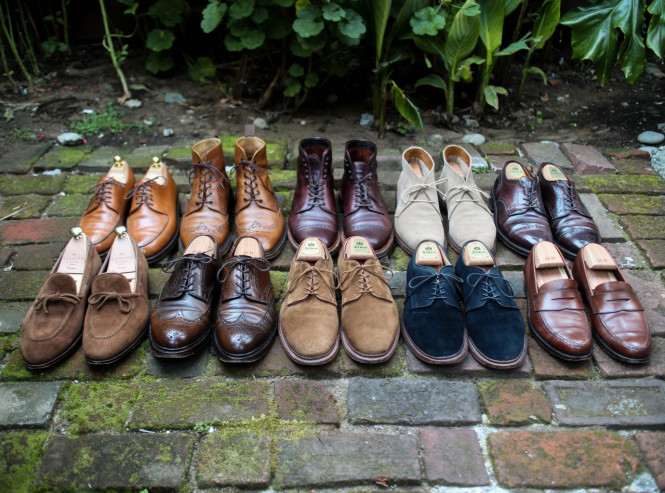The “In-Between Wardrobe” is a series of articles aimed at helping men find items that will play a versatile role in their closet. It is written with the idea that most men don’t wear extremely formal or casual clothing on a regular basis; they usually need items that are somewhere in the middle. See all articles in the series here.
Shoes are a critical element of in-between dressing, and are one area that is constantly being messed up by men that don’t know any better. The core idea behind finding an in-between shoe is balancing casual and formal features to achieve something that can be worn with a large variety of clothes.
First, it is important to understand what makes a shoe a “good” shoe and how to look for high-quality materials and construction in footwear. If you’re not familiar with these concepts, read my previous post on that topic. Once you’re on board with that, join in below.
1. Understand what makes a shoe casual or formal. Finding a great in-between shoe is about finding balance; go too far in the formal or casual direction and they will lose their versatility. To gauge a shoe’s formal/informal balance, remember the following principles:
- A smooth shine is more formal than texture. In other words, materials like suede, pebble grain, cordovan, and so forth are intrinsically less formal than plain calf leather.
- A sleek toe is more formal than a round toe. A shoe’s last determines the shape of a shoe; dressier options will have slimmer profiles or chiseled toes, while others will be rounder and follow the natural shape of a foot more closely. Compare this to this, for example.
- A leather sole is more formal than a rubber (or other synthetic) sole. Each type of sole has its own benefits and disadvantages, but a thin leather sole will appear more formal than a thicker double leather sole, and that will be more formal than a chunky rubber one.
- A dark color is more formal than a light color. Pretty self-explanatory.
- Fewer seams are more formal than more seams. Compare a wholecut to a captoe, for instance.
- No brogueing is more formal than brogueing.
- Closed lacing is more formal than open lacing. More on that in a minute.
2. Understand what an in-between shoe is not. I’m hesitating writing these because they are not hard-and-fast rules and can all be broken effectively; nonetheless, it’s easiest to avoid shoes with these characteristics if you’re looking for maximum versatility.
With that said, an in-between shoe is not:
- Closed laced. Closed lacing is one of the defining characteristics of oxford/balmoral shoes. Shoes with closed lacing are on the most formal tier and don’t look as correct with more casual clothing; they’re great for suits and can be worn with sportcoats, but an open-laced shoe will be more versatile. Don’t be the guy wearing sleek captoe oxfords with denim.
- Aggressively shaped. In-between shoes should have rounded toes because a strong point or chisel will evoke a formality that is incongruent with in-between clothing (and they also look best on closed laced shoes). Square-toed shoes are best avoided altogether.
- Black. If you’re just beginning then it’s probably best to save the black shoes for formal designs. There is a wide spectrum of browns, tans, and burgundies that look great on in-between shoes. While we’re at it, save the navy, green, and red for later too (if you get them at all).
3. Pick your style. So what designs make great in-between shoes? I’d say that there are four main categories, although options exist outside of these. They all can be found in a myriad of materials, shapes, and styles, so take some time finding what you like.
- Bluchers/Derbys: These are characterized by their open lacing pattern. This family includes variations of longwings, shortwings, plain toe bluchers, and captoes, to name a few.
- Boots: Many boots come in styles similar to bluchers – wingtips, captoes, etc – but there are also some new shapes introduced. For instance, chukka boots are one of the most versatile shoe styles out there, in my opinion.
- Loafers: there are many of styles and configurations to choose from, but the most popular are penny loafers and tassel loafers. I wrote an article on these here.
- Monksraps: Single and double monks can make great in-between shoes because their buckle configuration increases the casual appearance of an otherwise formal shoe. I’ve mentioned my opinion of double monks before, but I won’t deny that they are cool shoes.
4. Save up and buy something nice. Well-made shoes are expensive; it’s just an unfortunate truth. There is a huge range of prices, but none of them are cheap. If you’re comfortable going secondhand, ebay and thrift stores can be a great option. The list below covers some of my favorite makers, although there are plenty more.
- “Accessible” ($300 and under at MSRP): Loake (1880 line), Meermin Classic line, Jack Erwin, Markowski, Ed Et Al, Allen Edmonds (on sale/factory seconds), Rancourt
- Expensive ($300-$800 at MSRP): Crockett & Jones, Alden, Carmina, Alfred Sargent, Sid Mashburn (most made by Alfred Sargent), Peal & Co. for Brooks Brothers, Ralph Lauren
- Look but don’t touch: John Lobb, Edward Green, Vass, Gaziano Girling, St. Crispin
Shoutout to jacobbockelmann for letting me photograph his grail shoe collection for this post; few people understand the in-between wardrobe as well as he does so follow his blog for continued reading on that topic.
EDIT: for those that want to know the shoes in the picture above (L to R):
Top: Vass, Charles Tyrwhitt, Alden, Allen Edmonds, Alden
Bottom: Carmina, Ralph Lauren, Alden, Alden, Peal & Co. for BB
